Persistent Impact of In utero Irradiation on Mouse Brain Structure and Function Characterized by MR Imaging and Behavioral Analysis
- PMID: 27199692
- PMCID: PMC4854899
- DOI: 10.3389/fnbeh.2016.00083
Persistent Impact of In utero Irradiation on Mouse Brain Structure and Function Characterized by MR Imaging and Behavioral Analysis
Abstract
Prenatal irradiation is known to perturb brain development. Epidemiological studies revealed that radiation exposure during weeks 8-15 of pregnancy was associated with an increased occurrence of mental disability and microcephaly. Such neurological deficits were reproduced in animal models, in which rodent behavioral testing is an often used tool to evaluate radiation-induced defective brain functionality. However, up to now, animal studies suggested a threshold dose of around 0.30 Gray (Gy) below which no behavioral alterations can be observed, while human studies hinted at late defects after exposure to doses as low as 0.10 Gy. Here, we acutely irradiated pregnant mice at embryonic day 11 with doses ranging from 0.10 to 1.00 Gy. A thorough investigation of the dose-response relationship of altered brain function and architecture following in utero irradiation was achieved using a behavioral test battery and volumetric 3D T2-weighted magnetic resonance imaging (MRI). We found dose-dependent changes in cage activity, social behavior, anxiety-related exploration, and spatio-cognitive performance. Although behavioral alterations in low-dose exposed animals were mild, we did unveil that both emotionality and higher cognitive abilities were affected in mice exposed to ≥0.10 Gy. Microcephaly was apparent from 0.33 Gy onwards and accompanied by deviations in regional brain volumes as compared to controls. Of note, total brain volume and the relative volume of the ventricles, frontal and posterior cerebral cortex, cerebellum, and striatum were most strongly correlated to altered behavioral parameters. Taken together, we present conclusive evidence for persistent low-dose effects after prenatal irradiation in mice and provide a better understanding of the correlation between their brain size and performance in behavioral tests.
Keywords: MRI; brain development; cognition; microcephaly; radiation exposure; sociability.
Figures
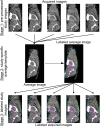


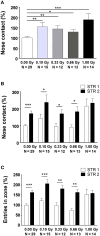
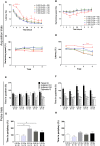

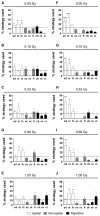

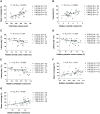
Similar articles
-
Noninvasive Assessment of Neurodevelopmental Disorders after In Utero Irradiation in Mice: An In Vivo Anatomical and Diffusion MRI Study.Radiat Res. 2021 Jun 1;195(6):568-583. doi: 10.1667/RADE-20-00136.1. Radiat Res. 2021. PMID: 33826744
-
A multidisciplinary approach unravels early and persistent effects of X-ray exposure at the onset of prenatal neurogenesis.J Neurodev Disord. 2015;7(1):3. doi: 10.1186/1866-1955-7-3. Epub 2015 Jan 9. J Neurodev Disord. 2015. PMID: 26029273 Free PMC article.
-
Effects of different doses of gamma-radiation on the developing brain of mice.Environ Med. 1995 Oct;39(2):113-6. Environ Med. 1995. PMID: 12703527
-
Early cognitive changes due to whole body γ-irradiation: a behavioral and diffusion tensor imaging study in mice.Exp Neurol. 2013 Oct;248:360-8. doi: 10.1016/j.expneurol.2013.06.005. Epub 2013 Jun 11. Exp Neurol. 2013. PMID: 23769909
-
Radiation-induced early changes in the brain and behavior: serial diffusion tensor imaging and behavioral evaluation after graded doses of radiation.J Neurosci Res. 2012 Oct;90(10):2009-19. doi: 10.1002/jnr.23073. Epub 2012 May 17. J Neurosci Res. 2012. PMID: 22605562
Cited by
-
Control of Neuroinflammation through Radiation-Induced Microglial Changes.Cells. 2021 Sep 10;10(9):2381. doi: 10.3390/cells10092381. Cells. 2021. PMID: 34572030 Free PMC article. Review.
-
Biological basis of radiation protection needs rejuvenation.Int J Radiat Biol. 2017 Oct;93(10):1056-1063. doi: 10.1080/09553002.2017.1294773. Epub 2017 Mar 13. Int J Radiat Biol. 2017. PMID: 28287035 Free PMC article. Review.
-
Interneuron migration impairment and brain region-specific DNA damage response following irradiation during early neurogenesis in mice.Cell Mol Life Sci. 2025 Mar 17;82(1):118. doi: 10.1007/s00018-025-05643-7. Cell Mol Life Sci. 2025. PMID: 40095026 Free PMC article.
-
Molecular and cognitive signatures of ageing partially restored through synthetic delivery of IL2 to the brain.EMBO Mol Med. 2023 May 8;15(5):e16805. doi: 10.15252/emmm.202216805. Epub 2023 Mar 28. EMBO Mol Med. 2023. PMID: 36975362 Free PMC article.
-
DNA damage and repair: underlying mechanisms leading to microcephaly.Front Cell Dev Biol. 2023 Oct 10;11:1268565. doi: 10.3389/fcell.2023.1268565. eCollection 2023. Front Cell Dev Biol. 2023. PMID: 37881689 Free PMC article. Review.
References
-
- Atwood T., Payne V. S., Zhao W., Brown W. R., Wheeler K. T., Zhu J. M., et al. . (2007a). Quantitative magnetic resonance spectroscopy reveals a potential relationship between radiation-induced changes in rat brain metabolites and cognitive impairment. Radiat. Res. 168, 574–581. 10.1667/RR0735.1 - DOI - PubMed
LinkOut - more resources
Full Text Sources
Other Literature Sources

